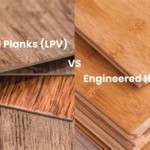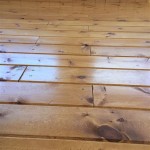Wood Floor Glued To Concrete: A Comprehensive Guide
The installation of wood flooring over a concrete subfloor is a common practice in both residential and commercial construction. When executed correctly, it offers the warmth, beauty, and durability of wood while leveraging the structural stability of concrete. However, the success of such an installation hinges significantly on the chosen method of adhesion. Gluing, or direct glue-down installation, presents a viable option, but its effectiveness depends on meticulous preparation, the selection of appropriate adhesives, and a thorough understanding of the inherent characteristics of both wood and concrete.
This article provides a comprehensive overview of gluing wood floors to concrete. It delves into the necessary preparation steps, explores the different types of adhesives available, outlines the installation process, and addresses potential challenges and troubleshooting techniques. This information aims to equip contractors, homeowners, and anyone involved in flooring projects with the knowledge required to achieve a successful and long-lasting wood floor installation over concrete.
Subfloor Preparation: The Foundation for Success
Proper subfloor preparation is arguably the most critical aspect of any successful wood flooring installation over concrete. A poorly prepared subfloor will inevitably lead to adhesion failures, moisture problems, and ultimately, premature floor deterioration. The concrete surface must be clean, level, dry, and structurally sound before any adhesive is applied.
Cleaning: The first step involves thoroughly cleaning the concrete surface. This typically requires removing any existing coatings, sealers, paint, adhesives, dirt, dust, grease, and any other contaminants that could interfere with the bond between the adhesive and the concrete. Mechanical methods, such as grinding, scraping, or shot blasting, are often necessary to remove stubborn residues. Sweeping, vacuuming, and even washing the floor with appropriate cleaning solutions may also be required.
Leveling: Concrete subfloors are rarely perfectly level. Variations in the surface can create unevenness in the finished wood floor, leading to tripping hazards, aesthetic imperfections, and potential structural problems. Self-leveling compounds are used to correct these irregularities. These compounds are specially formulated mixtures of cement, polymers, and other additives that flow freely over the concrete, filling in low spots and creating a smooth, level surface. The choice of self-leveling compound depends on the severity of the unevenness and the manufacturer's recommendations.
Moisture Testing: Concrete is porous and can wick moisture from the ground. Excessive moisture can cause wood floors to warp, buckle, and delaminate from the concrete. Therefore, it is imperative to conduct moisture tests to determine the moisture content of the concrete before installing the wood flooring. Several methods are available, including calcium chloride tests, relative humidity probes, and electronic moisture meters. The results of these tests should be compared to the flooring manufacturer's specifications to ensure that the moisture levels are within acceptable limits. If moisture levels are too high, mitigation strategies, such as the application of a moisture barrier, must be implemented.
Crack Repair: Cracks in the concrete subfloor can compromise the integrity of the adhesive bond. Small hairline cracks can often be filled with a concrete crack filler. Larger cracks, however, may require more extensive repairs, such as patching with a concrete repair mortar or even reinforcing the subfloor with a crack suppression membrane. The appropriate repair method depends on the size, depth, and nature of the crack. Consult with a concrete specialist to determine the best course of action.
Dust Removal: After all cleaning, leveling, and repair work is completed, the subfloor must be thoroughly vacuumed to remove any remaining dust and debris. Even a thin layer of dust can prevent proper adhesion. A high-powered vacuum with a HEPA filter is recommended for optimal dust removal.
Adhesive Selection: Choosing the Right Glue for the Job
The selection of the appropriate adhesive is crucial for a successful glue-down wood floor installation. Different types of adhesives possess distinct properties and are designed for specific applications. Factors to consider when choosing an adhesive include the type of wood flooring being installed, the concrete subfloor conditions, the environmental conditions, and the desired performance characteristics.
Polyurethane Adhesives: Polyurethane adhesives are among the most commonly used adhesives for gluing wood floors to concrete. They offer excellent adhesion, moisture resistance, and flexibility. They are suitable for a wide range of wood flooring types, including solid hardwood, engineered hardwood, and bamboo. Polyurethane adhesives typically come in one-part or two-part formulations. Two-part formulations generally offer superior performance but require mixing prior to application.
Silane-Modified Polymer (SMP) Adhesives: SMP adhesives offer several advantages over polyurethane adhesives. They are solvent-free, isocyanate-free, and low in VOCs, making them a more environmentally friendly option. They also exhibit excellent adhesion, moisture resistance, and elasticity. SMP adhesives are known for their ability to accommodate movement in the wood floor and concrete subfloor, reducing the risk of cracking and delamination. They are often preferred for wide plank wood flooring installations.
Acrylic Adhesives: Acrylic adhesives are water-based and offer good adhesion and flexibility. They are typically less expensive than polyurethane and SMP adhesives. However, they may not be as moisture resistant and are generally not recommended for use in areas with high humidity or potential moisture exposure. Acrylic adhesives are suitable for engineered hardwood and some types of solid hardwood flooring.
Epoxy Adhesives: Epoxy adhesives offer exceptional strength and durability. They are highly resistant to moisture and chemicals. However, they are also relatively rigid and may not accommodate movement in the wood floor or concrete subfloor as well as polyurethane or SMP adhesives. Epoxy adhesives are typically used for specialized applications, such as gluing wood flooring in commercial settings with heavy traffic or in areas exposed to harsh chemicals.
Considerations: It is important to consult with the flooring manufacturer and the adhesive manufacturer to determine the appropriate adhesive for the specific wood flooring and subfloor conditions. The adhesive manufacturer's instructions should be followed carefully to ensure proper application and curing. Factors such as trowel notch size, open time, and curing time can significantly affect the performance of the adhesive.
Installation Process: A Step-by-Step Guide
The glue-down wood floor installation process requires careful planning and execution. Following a systematic approach and adhering to the manufacturer's instructions are essential for achieving a successful and long-lasting installation.
Acclimation: Wood flooring must be acclimated to the job site conditions before installation. This allows the wood to adjust to the temperature and humidity levels of the environment, minimizing expansion and contraction after installation. The recommended acclimation period varies depending on the type of wood, the climate, and the manufacturer's instructions. Typically, the wood flooring should be stored in the room where it will be installed for several days or even weeks before installation.
Layout: Before applying any adhesive, it is important to plan the layout of the wood flooring. This involves determining the direction of the planks, the starting point, and the placement of any decorative elements. A dry layout allows for adjustments to be made before the adhesive is applied, minimizing waste and ensuring a visually appealing finished product.
Adhesive Application: The adhesive should be applied to the concrete subfloor using a notched trowel. The size and type of the notch should be specified by the adhesive manufacturer. Apply the adhesive in small sections, typically no more than can be covered with flooring within the adhesive's open time. Working in manageable sections prevents the adhesive from drying out before the flooring is installed. The adhesive should be applied evenly and consistently to ensure proper coverage.
Flooring Installation: Place the wood flooring planks onto the adhesive, ensuring that they are properly aligned and tightly butted together. Use shims or spacers to maintain consistent expansion gaps around the perimeter of the room and around any fixed objects. Roll the flooring with a heavy roller to ensure full contact between the wood and the adhesive. This helps to eliminate air pockets and promote a strong bond.
Curing: Allow the adhesive to cure completely before allowing foot traffic on the floor. The curing time varies depending on the type of adhesive, the temperature, and the humidity. Consult the adhesive manufacturer's instructions for the recommended curing time. Avoid placing heavy objects on the floor during the curing process.
Finishing: Once the adhesive has cured, remove any shims or spacers. Install baseboards, trim, and any other finishing elements. Clean the floor thoroughly to remove any adhesive residue or debris.
Troubleshooting and Common Problems
Despite careful planning and execution, problems can sometimes arise during or after a glue-down wood floor installation. Understanding common issues and knowing how to address them can help to minimize damage and ensure a satisfactory outcome.
Adhesion Failure: Poor adhesion is one of the most common problems encountered with glue-down wood floors. This can be caused by inadequate subfloor preparation, the use of an inappropriate adhesive, improper adhesive application, excessive moisture, or contamination. If adhesion failure occurs, the affected flooring must be removed, the subfloor must be re-prepared, and new adhesive must be applied.
Moisture Problems: Excessive moisture can cause wood floors to warp, buckle, and delaminate. This can be caused by moisture migrating from the subfloor, leaks, or high humidity. If moisture problems are detected, the source of the moisture must be identified and corrected. The affected flooring may need to be removed and replaced. In some cases, a moisture barrier may be necessary to prevent future moisture problems.
Gapping: Gapping between wood flooring planks can occur due to changes in humidity or temperature. This is more common with solid hardwood flooring. To minimize gapping, it is important to acclimate the wood flooring properly before installation and to maintain consistent humidity levels in the home. In some cases, gapping can be filled with wood filler or caulking.
Squeaking: Squeaking can occur when wood flooring planks rub against each other or against the subfloor. This can be caused by loose planks, uneven subfloors, or inadequate adhesive coverage. To address squeaking, try injecting adhesive into the joints between the planks or adding shims underneath the planks to provide support.
Cupping: Cupping occurs when the edges of the wood flooring planks rise above the center. This is typically caused by excessive moisture on the underside of the planks. To address cupping, identify and correct the source of the moisture. The affected flooring may need to be removed and replaced.

How To Install Tongue Groove Hardwood Floors Over Concrete

How To Install Engineered Wood Flooring On Concrete

Fitting Hardwood Floor To Concrete Wood And Beyond Blog

Hardwood Over Concrete Auten Wideplank Flooring

Gluedown 7 2 16 Hb

How To Install A Glue Down Floor Diy Flooring

Glue Wood Flooring To A Concrete Slab Fine Homebuilding

Can You Glue Down Solid Wood Flooring Hardwood Guide Reallyfloors America S Est

Getting It Right Wood Flooring Over A Concrete Subfloor Page 2 Of 3 Construction Specifier

How To Remove Glued Wood Flooring And Engineered On Concrete







